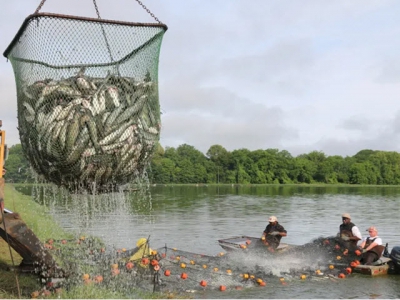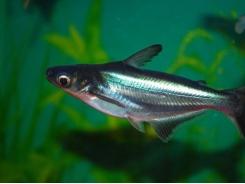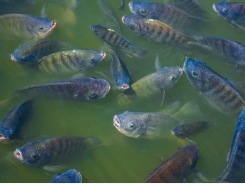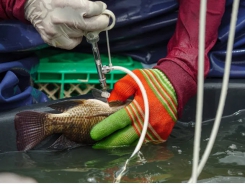Feed ingredients and feeds for channel catfish - Part 1

This factsheet by the Southern Regional Aquaculture Center (SRAC) gives information on what feeds and feed ingredients should be used for channel catfish.
Catfish harvesting. Photo: Auburn University
A new factsheet published by the Southern Regional Aquaculture Centre (SRAC), explains the key facts about what ingredients are suitable for formulating feeds for channel catfish.
In the southeastern United States, channel catfish are generally cultured in earthen ponds at relatively high densities. The intensive culture system requires that the fish be fed a nutritionally complete diet that provides nutrients and energy at or above the required levels for optimum growth and feed efficiency. This is mainly because the amount of natural food in the pond is relatively small compared to the total nutrient requirements of the fish, except in early stages of life (fry and small fingerlings).
Feed represents the largest variable cost in catfish production. While the need for more economical feeds is clear, it is imperative that catfish feeds are formulated to be cost-effective, not just less costly. This can be achieved by carefully selecting and blending various traditional and alternative feedstuffs that are suitable for use in catfish feeds. It is important that using less expensive alternative feedstuffs not degrade the nutritional and physical quality of the feed, fish growth, processed yield, and product quality. In this publication we examine various feed ingredients that are or could be used in catfish feeds, as well as feed formulation guidelines and various types of feeds.
Feed ingredients
Commercial catfish feeds are a mixture of feedstuffs and vitamin and mineral supplements that provide adequate amounts of essential nutrients and digestible energy. To be suitable, dietary ingredients must be highly digestible, easily handled in the manufacturing process, able to withstand the rigors of the manufacturing process, available on a consistent basis, economical, and contain sufficient nutrients. Although all feedstuffs contain energy, protein, and other nutrients, they are usually classified as either protein or energy feedstuffs. In animal feeds, those containing 20 percent protein or more are generally referred as protein feedstuffs, and those containing less than 20 percent protein are energy feedstuffs. Protein feedstuffs are further divided by the source, either animal or plant. There are many feedstuffs that may be nutritionally suitable for use in catfish feeds, but relatively few are readily available on a timely basis and at reasonable cost. Although we will consider all types of feedstuffs, we will focus mostly on protein feedstuffs, as protein is the most costly fraction of catfish feeds.
Protein content
The primary protein sources used in catfish feeds are oilseed meals, such as soybean meal and cottonseed meal; peanut meal and canola meal also can be used. Compared to animal proteins, most plant proteins, except for soybean meal, are deficient in lysine, the most limiting essential amino acid in catfish feeds. Also, certain plant proteins contain antinutritional factors and toxins (see SRAC Publication No. 5002, Mycotoxins in Aquaculture Feeds). Some antinutrients, such as trypsin inhibitor, are inactivated by heat during extrusion, but others, such as phytate, are unaffected by heat treatment. Other processing methods may be used to reduce levels of some antinutrients. Although there are exceptions, animal proteins are generally considered to be of higher quality than plant proteins, primarily because they typically contain more indispensable amino acids and do not contain antinutritional factors (see SRAC Publication No. 5003, Principles of Fish Nutrition). Animal proteins that have been used in catfish feeds include fish meal, meat and bone meal, blood meal, meat and bone/blood meal blend, poultry by-product meal, and catfish offal meal. These animal proteins, especially fish meal, are more expensive than plant proteins. Although there have been conflicting reports, properly balanced diets with all-plant proteins can provide satisfactory growth of catfish raised in ponds from advanced fingerlings to market size. Soybean meal, dehulled, solvent-extracted, is obtained by grinding the flakes remaining after removing most of the oil from dehulled soybeans by a solventextraction process. It contains about 48 percent highquality protein and is the predominant protein source in catfish feeds. Soybean meal has the best amino acid profile of all common plant protein sources and is highly palatable and digestible to catfish. Antinutritional factors, such as trypsin inhibitor, are destroyed or reduced to insignificant levels with heat that is applied during the extraction process. Levels of soybean meal up to 50 percent have been used in commercial catfish feeds without detrimental effects. In recent years, its use has been reduced somewhat because of increasing cost. Cottonseed meal, solvent-extracted, is obtained by finely grinding the flakes that remain after removing most of the oil from cottonseed by a solvent-extraction process. It generally contains about 41 percent protein, but must not contain less than 36 percent. It is highly palatable to channel catfish. Cottonseed meal contains free gossypol and cyclopropenoic acids, which can be toxic at high levels; however, in commonly available cottonseed meal these compounds are generally well below toxic levels. Cottonseed meal has generally been used in catfish feeds at a level of 10 to 15 percent, but levels up to 30 percent with lysine supplements can be used to replace part of the soybean meal in catfish feeds. Distillers dried grains with solubles (DDGS) is the product obtained after removing ethyl alcohol by distillation from the yeast fermentation of grain or grain mixture. The predominant product in the U.S. is the DDGS from corn. The product contains approximately 27 percent protein and is highly palatable to catfish. Because oil is of higher value, some of the DDGS is solvent-extracted to remove part of the oil for human consumption and biodiesel production. Studies have shown that levels of DDGS up to 40 percent, with lysine supplement, can be used in catfish feeds without affecting fish growth. However, DDGS from yellow corn contains a relatively high level of yellow pigments (mainly lutein and zeaxanthin), which may be deposited in the catfish product and make it unacceptable to the typical consumer. A level of 10 to 20 percent may be used as long as the yellow pigments in the finished diet do not exceed about 7 ppm. Peanut meal, mechanical- or solvent-extracted, is a ground product of shelled peanuts composed of the kernels and hulls (fiber) or oil left in the ordinary course of mechanical or solvent extraction. It contains about 45 to 47 percent protein and must not contain more than 7 percent crude fiber. Peanut meal is highly palatable to catfish and has no known antinutritional factors, but it is prone to become contaminated with mold, which produces aflatoxins. It is seldom used because of its sporadic availability. Canola meal, solvent-extracted, consists of the meal obtained after removing most of the oil (by mechanical or solvent extraction) from the whole canola seeds. Canola refers to varieties of rapeseed specially bred to contain much lower levels of the toxic glucosinolates and erucic acid. Canola meal contains about 38 percent protein. Up to 25 percent canola meal can be used to replace part of the soybean meal in feed. It is rarely used in catfish feeds because it often is not cost-effective and is in limited supply. Fish meal is the clean, dried, ground tissues of undecomposed whole fish or fish cuttings. Sometimes part of the oil has been extracted. Fish meal generally refers to products from marine sources, and the most common fish meal used in the US is menhaden meal. Fish meal contains 60 to 80 percent protein of excellent quality that is highly palatable to catfish. It is also rich in energy, essential fatty acids, and minerals. It has been used at levels of up to 60 percent in catfish fry feeds, up to 15 percent in fingerling feeds, and up to 12 percent in food fish feeds. Because of its high cost, little, if any, fish meal is used in commercial catfish feeds except for fry feeds. Porcine meat and bone meal is the rendered product from pork processing, exclusive of any blood, hair, hoof, hide trimmings, manure, or stomach contents (except in amounts as may occur unavoidably in good processing practices). It contains approximately 52 percent crude protein. Its protein quality is inferior to whole fish meal because it contains less lysine. Although it is a good source of minerals, its high ash content may limit its use because of possible mineral imbalance. The maximum level of meat and bone meal recommended for catfish feeds is 15 percent of diet. Porcine meat and bone/blood meal blend is a mixture of meat and bone meal and blood meal from pork processing. The two ingredients are mixed to mimic the nutritional profile of menhaden fish meal (at least in regard to lysine). The blended product provides 60 to 65 percent protein (an excellent protein source for catfish feeds) and is generally used as a replacement for fish meal. Poultry by-product meal consists of the ground, rendered, clean parts of the carcass of slaughtered poultry, such as necks, feet, undeveloped eggs, and intestines. It does not include feathers, except in such amounts as might occur unavoidably in good processing practices. Feed-grade poultry by-product meal contains approximately 60 percent protein and is an excellent product for use in catfish feeds. However, it is not available on a regular basis at a reasonable cost per unit of protein. Hydrolyzed poultry feathers is the product resulting from the treatment under pressure of clean, undecomposed feathers from slaughtered poultry. It is free of additives. At least 75 percent of its crude protein must be digestible by the pepsin digestion method. It is high in protein (85 percent), but deficient in several essential amino acids, especially lysine. Hydrolyzed poultry feathers are rarely used in catfish feeds because of the low levels of essential amino acids and low palatability to catfish.
Energy content
Energy feedstuffs used in commercial catfish feeds are primarily grains (corn and wheat) and grain by-products (corn gluten feed, corn germ meal, wheat middlings, and rice bran), animal fat, and fish oil. Corn has traditionally been used as the main energy source in catfish feeds. Corn improves the expansion of feed pellets during extrusion, resulting in a pellet that floats. Because of recent dramatic increases in its price, less corn is being used in catfish feeds. However, a minimum of 15 percent corn should be included in the feed to ensure proper expansion and floatability of feed pellets. Wheat is a good source of energy for catfish and a good pellet binder, but it is generally more expensive than corn and is seldom used in catfish feeds. However, wheat by-products such as wheat middlings are typically used. Wheat middlings consist of fine particles of wheat bran, shorts, germ, flour, and some of the offal from the milling of wheat. Depending on cost, wheat middlings are generally used to replace corn and/or wheat in catfish feeds. It can be used at levels up to 25 percent of diet. Corn gluten feed is the part of the shelled corn that remains after the extraction of the larger portion of the starch, gluten, and germ in the wet milling manufacture of corn starch or syrup. It typically contains 21 percent crude protein (it is referred to as an energy feedstuff here because it is mainly used to replace the energy feedstuffs corn and wheat middlings in catfish diets). Corn gluten feed is usually competitively priced relative to corn and wheat middlings. Catfish feeds can contain up to 30 percent corn gluten feed without detrimental effects. Unlike high-protein corn gluten meal, corn gluten feed contains a level of yellow pigments similar to that in corn grain. Corn gluten feed is less digestible than corn grain. Corn germ meal is ground corn germ, which consists of corn germ with other parts of the corn kernel from which part of the oil has been removed. The product is obtained by the dry milling process to manufacture corn meal, corn grits, hominy feed, and other corn products, or by the wet milling process to manufacture corn starch, syrup, etc. The product contains 18 to 20 percent protein. It has less yellow pigment than corn gluten feed and corn. It can be used in catfish feeds at levels up to about 35 percent of diet. The digestible energy of corn germ meal is lower than that of corn grain. Rice bran is the bran layer and germ of the rice, with only such quantity of hull fragments and broken rice as is unavoidable in the regular milling of edible rice. It is high in fat, which limits its use in catfish feeds. Because of its high fat content and a potent lipase enzyme, rice bran oxidizes rapidly and becomes rancid under normal storage conditions. Rice bran can be stabilized by heat and pressure treatment to inactivate the lipase enzyme. No more than 5 percent of full-fat rice bran may be used in catfish feeds. Solvent-extracted and stabilized rice bran can be used at higher levels (up to 15 percent). It is rarely used in catfish feeds because it is not regularly available and because some feed manufacturers report that it is highly abrasive to feed processing equipment. Fats and oils from animals or plants are highly concentrated sources of energy and contain essential fatty acids and fat-soluble vitamins. Animal fats and oils used in catfish feeds include catfish offal oil, menhaden oil, and poultry fat. Plant oils can be used, but are generally too expensive. Supplemental fat/oil is generally sprayed on the finished feed pellet at a rate of 1 to 2 percent, primarily to reduce feed dust or “fines.”
Có thể bạn quan tâm
Phần mềm

Phối trộn thức ăn chăn nuôi

Pha dung dịch thủy canh

Định mức cho tôm ăn

Phối trộn phân bón NPK

Xác định tỷ lệ tôm sống

Chuyển đổi đơn vị phân bón

Xác định công suất sục khí

Chuyển đổi đơn vị tôm

Tính diện tích nhà kính

Tính thể tích ao hồ




 Feed ingredients and feeds for channel catfish -…
Feed ingredients and feeds for channel catfish -…  High hopes for an oral Francisella vaccine for…
High hopes for an oral Francisella vaccine for…